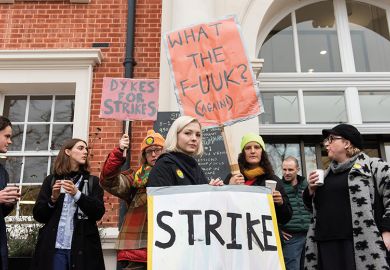Members of the UK’s Universities Superannuation Scheme (USS) could be forgiven for having reacted with despair to the market turmoil unleashed by the now ex-chancellor’s recent “mini-budget”. No sooner had the scheme’s group chief executive, Bill Galvin, begun to strike a more optimistic note on the future of the scheme, after years of industrial strife over reduced benefits and increased contributions, than market conditions took a decided turn for the worse.
Galvin’s major theme, expressed in an article for Times Higher Education in August, was that if something like the USS’ then-reported situation was sustained, the next valuation in 2023 might allow reductions in contributions, some improvement of benefits or a mixture of both. But now the USS is facing higher inflation, declining security prices (especially of government bonds) and great uncertainty, offset by surging interest and discount rates.
Still, the USS was not among the defined-benefit schemes facing demands for greater collateral (bond sales) from suppliers of financial instruments that are supposed to protect against market fluctuations. And some stability has been regained following the Bank of England’s short-term bond-buying intervention but, Kwarteng’s -sacking and the reinstatement of some previous tax cuts has left the market wanting more changes.
However, USS briefings themselves are fairly reassuring. Although the value of the scheme’s assets will have declined very substantially, the higher interest rates will have reduced the value of its liabilities by more. The USS says its current position still provides a positive platform for discussing options for the 2023 valuation – subject to the market’s great volatility.
Based on USS information about the market conditions in June – more promising than the information on which Galvin based his THE piece – my conclusion is that if those conditions were to endure and if contributions remain at current levels, all the major cuts made to benefits in recent years may be reversed.
The £14.1 billion deficit of the 2020 valuation, which led to swingeing cuts in future benefits, is transformed into a surplus of £1.8 billion. With the cuts and no deficit, the only annual contributions required are for the promised benefits accruing to members for working a future year (“future services contributions”), amounting to 21.2 per cent of salaries.
Unlike the USS’ previous monitoring reports in February and March, the June report does not give any information about the contributions required without the cuts. But my estimate of 31.8 per cent is broadly in line with estimates the USS belatedly published on 3 October in a rather obscure part of its website (the USS has refused to add this information to its future monitoring reports, hindering the debate). Since the total contributions required of employers and employees until the next valuation are 31.4 per cent of salaries (employers 21.6 per cent, employees 9.8 per cent), this would allow the cuts to be completely restored with existing contributions.
At the other extreme, if the cuts are maintained, contributions may be reduced by 10.2 per cent.
The three major cuts are:
- Reducing the threshold for the switch from the defined benefit element of the hybrid scheme to its defined contribution element from £60,000 to £40,000
- Decreasing the accrual rate per year from 1/75 to 1/85
- Replacing the inflation soft cap, which provides full protection from the first five percentage-point increase in CPI and a 50 per cent reduction on the next five percentage-point rise, with a hard cap protecting up to only a 2.5 per cent increase, deferred for two years.
Reversing the first cut will help only those active pension members with salaries between £40,000 and £60,000 and may affect these individuals differently. Reinstating the other two cuts will aid all active members, with reinstating the soft cap especially helpful to younger, lower salaried members. Older members with higher salaries will gain more in money terms from any restoration.
Changes in benefits and contributions are a matter for the Joint Negotiating Committee (JNC), consisting of five representatives each from the University and College Union and employers (Universities UK) and an independent chair. It would help the discussion if the USS could provide the JNC with the contribution costs of restoring each of the cuts as these are difficult to determine accurately using currently published information. Indeed, if this information were in future monitoring reports it might remove confusions currently reigning about the options available and how these might be used.
Either way, however, priorities may vary widely among stakeholders. Both the USS and the Pension Regulator will probably be concerned about the risk of a full restoration; they will wish to ensure that contributions provide a buffer against the expected volatility of the environment.
The UCU, meanwhile, seeks the reinstatement of all cuts as soon as possible. UUK’s stance is harder to discern; it welcomes the possibilities for change, but its only specific illustration is a further deferment of the hard cap – costing a trivial amount per year. And it says a contribution rate of more than the current 21.6 per cent would have devastating consequences, including job losses.
I suspect employers will focus on a softer inflation cap and some reduction in employee contributions via a lower-cost option for young members. They may seek to reduce their contributions to levels they have said they can tolerate – around 18-20 per cent. But this is likely to cause further industrial action.
Indeed, more industrial inaction is inevitable if stubborn demands for either major reductions in contributions or “no detriment” to benefits remain. An improved pension requires both employers and the union to abandon such red lines.
Michael Bromwich is CIMA professor of accounting and financial management, emeritus, at the London School of Economics and Political Science.
Register to continue
Why register?
- Registration is free and only takes a moment
- Once registered, you can read 3 articles a month
- Sign up for our newsletter
Subscribe
Or subscribe for unlimited access to:
- Unlimited access to news, views, insights & reviews
- Digital editions
- Digital access to THE’s university and college rankings analysis
Already registered or a current subscriber?








